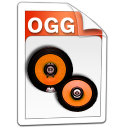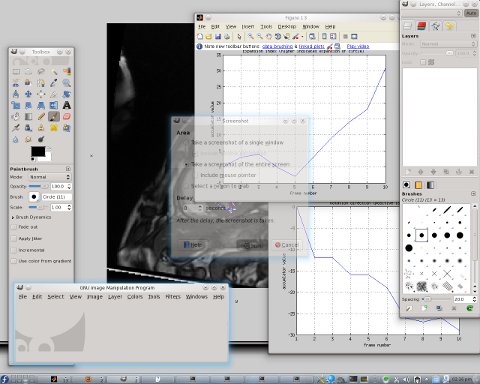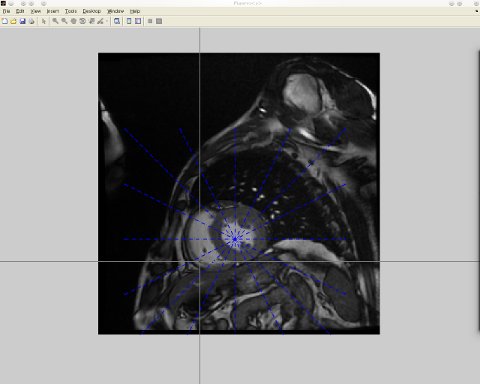 currently put the final touches on my program which detects and analyses the movement of the heart using the fiesta protocol in an MRI-type modality (1.5 Tesla).
currently put the final touches on my program which detects and analyses the movement of the heart using the fiesta protocol in an MRI-type modality (1.5 Tesla).
Recent and very simplistic experiments, where two rather distinct images were taken from the set and then rotated, were used such that the only real and anatomical shift is a rigid, geometric one. Two sorts of transformations were used; firstly, in two cases the images were rotated about the middle and in one case the rotation was around one of the corners. This gave different types of variations and various parameters were changes until the algorithm was able to track the points (placed at the edges) rather well. There are now new parameters in place, e.g. (in this case):
threshold = 1
transform_type = sum
frame_size = 2
shuffle_radius = 1
draw_grid = 0
arrow_type = gradient
verbosity = 1
output_type = image
draw_circles = 1
triagulate = 1
measure_tangent_component = 1
search_along_gradient = 1
gradient_search_range = 2
boundaries_line_width = 2
...
Going under the suffix “mid” (slice 3 from the bottom) we have an example of how the landmark points get moved between the frames.

Initial frame

Initial frame with landmark points on

Initial frame with connected landmark points

Position of landmark points at the end of the tracking sequence
Looking at edge detectors we have the possibility of fusion for improved tracking — with a two-tier image, one for the derivative and another being the original.

Sample image

Sobel edge detection of the image

Prewitt edge detection of the image
As an engine, I am currently using MATLAB for reasons of succession (other users of the program I built are less likely to run it in Octave like I do), but I don’t touch the MATLAB ‘desktop’, just the bash shell and vi as the editor (ncurses).

![]() Today’s show ends with the usual theme track. We hope you will join us for future shows and consider subscribing to the show via the RSS feed. You can also visit our archives for past shows. If you have an Identi.ca account, consider subscribing to TechBytes in order to keep up to date.
Today’s show ends with the usual theme track. We hope you will join us for future shows and consider subscribing to the show via the RSS feed. You can also visit our archives for past shows. If you have an Identi.ca account, consider subscribing to TechBytes in order to keep up to date.





 Filed under:
Filed under: 
 ikileaks is currently mirrored on 1426 up-to-date sites (updated 2010-12-21 20:29 GMT)
ikileaks is currently mirrored on 1426 up-to-date sites (updated 2010-12-21 20:29 GMT) currently put the final touches on my program which detects and analyses the movement of the heart using the fiesta protocol in an MRI-type modality (1.5 Tesla).
currently put the final touches on my program which detects and analyses the movement of the heart using the fiesta protocol in an MRI-type modality (1.5 Tesla).







 ESTERDAY I encountered my first major setback in Octave for Kubuntu. It was a bug, not a missing feature. It involved an outside library again. I tried installing a newer version of gnuplot (installing the latest one by compiling the source code), but this did not resolve the issue. All in all, over an hour was spent on it, first assuming that I was coding wrongly and later realising that
ESTERDAY I encountered my first major setback in Octave for Kubuntu. It was a bug, not a missing feature. It involved an outside library again. I tried installing a newer version of gnuplot (installing the latest one by compiling the source code), but this did not resolve the issue. All in all, over an hour was spent on it, first assuming that I was coding wrongly and later realising that 
